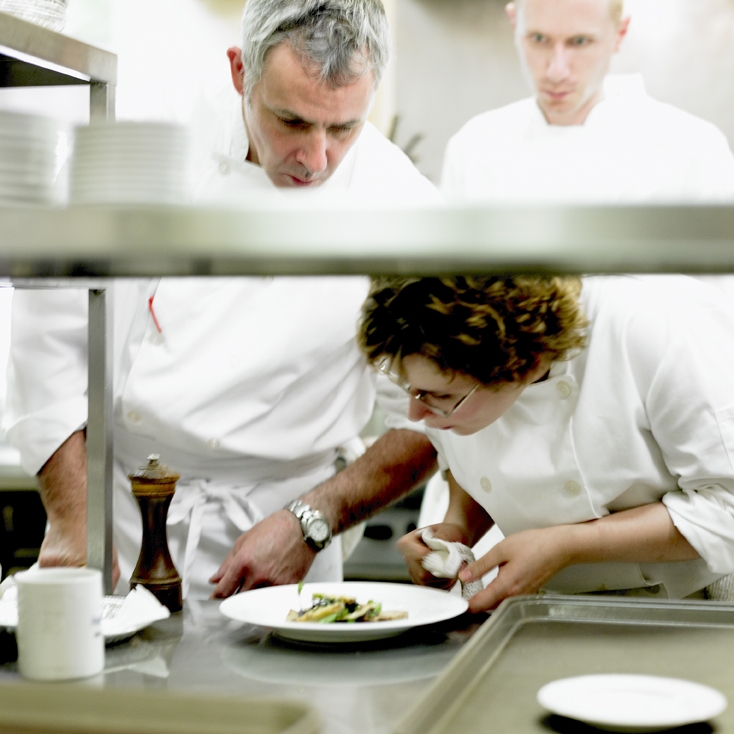Butter is as old as Western civilization. In ancient Rome, it was medicinal--swallowed for coughs or spread on aching joints. In India, Hindus have been offering Lord Krishna tins full of ghee —luscious, clarified butter —for at least 3,000 years. And in the Bible, butter is a food for celebration, first mentioned when Abraham and Sarah offer three visiting angels a feast of meat, milk and the creamy yellow spread.
Butter’s origins are likely more humble, though. Rumor has it a nomad made the first batch by accident. He probably tied a sheepskin bag of milk to his horse and, after a day of jostling, discovered the handy transformation so many generations have noticed and learned to apply: Churned milk fat solidifies into something amazing. The oldest known butter-making technique still in use today is remarkably similar: Farmers in Syria skin a goat, tie the hide up tight, then fill it with milk and begin shaking.
Although some of the earliest records of butter consumption come from Roman and Arabian sources, Mediterranean people have always favored oil in their cooking. Butter, it seems, was the fat of choice for the tribes of northern Europe — so much so that Anaxandrides, the Greek poet, derisively referred to barbarians from the north as “butter-eaters.” Climate likely played a key role in regional tastes, as the cool weather at northern latitudes allowed people to store butter longer than Mediterranean cultures could. By the 12th century, the butter business was booming across northern Europe. Records show that Scandinavian merchants exported tremendous amounts each year, making the spread a central part of their economy. Butter was so essential to life in Norway, for example, that the King demanded a full bucket every year as a tax.
By the Middle Ages, eaters across much of Europe were hooked. Butter was popular among peasants as a cheap source of nourishment and prized by nobility for the richness it added to cooked meats and vegetables. For one month out of each year, however, the mostly-Christian Europeans made due without their favorite fat. Until the 1600s, butter-eating was banned during Lent. For northern Europeans without access to cooking oils, meal-making could be a struggle during the weeks before Easter. Butter proved so necessary to cooking, in fact, that the wealthy often paid the Church a hefty tithe for permission to eat the fat during the month of self-denial. Demand for this perk was so high that in Rouen, in northwestern France, the Cathedral’s Tour de Beurre — or Butter Tower — was financed and built with such tithes.
Across the English Channel in Ireland, butter was so critical to the Irish economy that merchants opened a Butter Exchange in Cork to help regulate the trade. Today, barrels of ancient Irish butter, which were traditionally buried in bogs for aging, are among the most common archeological finds in the Emerald Isle. In France, butter was in such high demand by the 19th century that Emperor Napoleon III offered a large prize for anyone who could manufacture a substitute. In 1869, a French chemist won the award for a new spread made of rendered beef fat and flavored with milk. He called it “oleomargarine,” later shortened to just margarine.
Across the Atlantic, butter consumption started with the pilgrims, who packed several barrels for their journey on the Mayflower. During the next three centuries, butter became a staple of the American farm. At the turn of the 20th century, Americans’ annual consumption was an astonishing 18 pounds of butter per capita—nearly a stick and a half per person per week!
The Great Depression and World War II challenged America’s love affair with butter. The turmoil brought shortages and rationing, and margarine — now made with vegetable oil and yellow food coloring — became a cheaper option for American families. Butter consumption took a nosedive. In addition, dieticians and the USDA began promoting a low-fat diet in the 1980s, and butter became déclassé. By 1997, consumption had fallen to 4.1 pounds per capita per year.
Since then, however, butter has staged a comeback. Researchers have discovered that the ingredients in old-style margarine are significantly worse for heart health than the saturated fats found in natural butter. The news has lured more and more Americans back to their buttery traditions. The passion for delectable cuisine is bolstering consumption once again as artisanal butters appear in chilled grocery cases across the country. And at top restaurants around the globe, chefs are doing extraordinary things with this millennia-old food, creating an exciting new page in the history of butter.










































